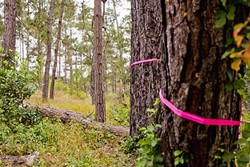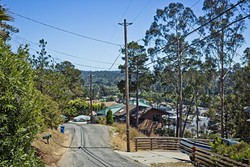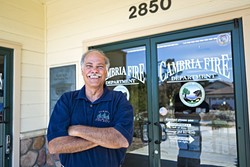Cutting down catastrophe: Cambria slowly scrambles to confront a pressing fire danger
By Jono Kinkade[{
"name": "Newsletter Promo",
"id": "NewsletterPromo",
"class": "inlineCenter",
"insertPoint": "4",
"component": "15264767",
"requiredCountToDisplay": "0"
},{
"name": "Ad - Medium Rectangle CC01 - 300x250",
"id": "AdMediumRectangleCC01300x250",
"class": "inlineCenter",
"insertPoint": "8",
"component": "2963441",
"requiredCountToDisplay": "12"
},{
"name": "Ad - Medium Rectangle LC01 - 300x250",
"id": "AdMediumRectangleCC01300x250",
"class": "inlineCenter",
"insertPoint": "18",
"component": "2963441",
"requiredCountToDisplay": "22"
},{
"name": "Ad - Medium Rectangle LC09 - 300x250",
"id": "AdMediumRectangleLC09300x250",
"class": "inlineCenter",
"insertPoint": "28",
"component": "3252660",
"requiredCountToDisplay": "32"
}]
California is burning.
In some parts of the state, it’s the slow, long burn of dehydration, brought on by the worst drought on record. Trees are drying and dying, grasses are a pale brown, and shrubs are more brittle than they’ve ever been.
In other places, that dry vegetation is fueling flames as fire sweeps through wild lands, hillsides, and even homes.
As this article goes to press, the Cuesta Fire—which began on the Cuesta Grade along northbound Highway 101 and crept up the East Ridge in the evening of Aug. 16, burning 40 acres and spreading to 2,500 in two days—continued eating fuel along the hillsides. As the winds blew that fire northeast up and over the grade toward the town of Santa Margarita, evacuation orders were issued, and fire crews amassed to build a last line of defense.
People had at least a few hours’ notice before it was time to collect their things, pause, and see what happened next. An evacuation center was set up to the north at Santa Rosa Academic Academy in Atascadero.
If a similar scenario happened in Cambria, things may be different. In the north coast town nestled into a 3,200-acre Monterey pine forest, where trees are dying at an alarming rate, residents may not have much time to react in the face of fire.
There, residences and trees intermingle, with pines and oaks surrounding many of the town’s inhabitable buildings. The town is patchworked with undeveloped lots, which themselves are peppered with trees and grass. Many of the lots without houses are subject to a building moratorium issued by San Luis Obispo County that likely won’t be lifted until the town’s significant water-supply woes are sorted out.
Navigating through Cambria often requires traversing narrow, windy roads; a confused turn may lead to a dead end or into a ravine with no apparent exit. A fallen tree or a vehicle collision can easily become an impassable hindrance. Cell phone service is spotty, mobile Internet service is worse, and relying on Google Maps is a crutch best left back where you came from, where things probably make more sense.
According to the U.S. census, almost one-third of the 6,000 residents are 65 or older, which—no offense to the nimble 70-somethings out there—means there’s a sizeable demographic that may not be the quickest in an emergency. Tourists filling the hotels along the coast or wandering through the shops along Main Street may be caught disoriented, not knowing what exactly to do or where to go.
Once out of the labyrinth, there are really only two ways out—Highway 1 north, or Highway 1 south.
The setting is often compared to the scene of the disastrous 1991 Oakland-Berkeley Hills fire, where a grassfire roared through the hilly area along the wild land-urban interface. The winds blew strong that day; the rugged terrain and windy, narrow residential streets made evacuation difficult. All told, 25 people lost their lives, 150 people were injured, and 2,843 single-family dwellings and 433 apartment units were destroyed among the 1,520 acres burned. Estimated losses totaled $1.5 billion.
Yes, the situation in Cambria is serious.
But by now, none of this should be a surprise.
At the onset of spring, local officials were well aware of the situation and were already enlisting community participation in a proactive approach to a summer with heightened fire risk. Clearing large swaths of ecological reserves and private property was being considered. Even the San Luis Obispo County grand jury got involved, eventually doing what it does best—stating the obvious.
In the introduction, the report In a State of Emergency—Assessing Fire Risk in Cambria reads: “Cambria is a coastal community long known for water supply issues. As of March 2015, it remains in a Stage 3 (most severe) water emergency. Cambria also faces another severe, but less recognized emergency risk—the potential for a catastrophic fire. The risk level for such a fire is heightened by the town’s combination of geography, urban buildup, and current drought.”
The report continues: “A break in the drought will not restore life to these dead trees; until these trees are dealt with, their fire risk will remain.”
So, by the end of the spring, it seemed like the entire village was somehow involved in addressing the fire risk, jumping into a developing story that already had the attention of several government agencies.
No small task
In March, then-Cambria Fire Department Chief Mark Miller, who has since retired, walked New Times through the complexity of addressing the issue.
“It’s that old adage of how do you eat an elephant? One bite at a time,” Miller said. “It comes back to that. We need to get started somewhere.”
The community did start and is pursuing a popular fire fighting strategy—prevention. The basic idea is simple: Humans must get to the fuel load before a fire does. In practice: It’s a very complicated process.
SLO Cal Fire Chief Rob Lewin estimates that there are at least 20,000 dead trees throughout the forest. Those trees, and the forest, are spread across property line after property line, making the process of tree removal as much a private property issue as it is a fire reduction and forest management issue.
Many of those trees, for example, are on the Covell Ranch, which is the largest single private land holding of Monterey pines anywhere, said Dan Turner, a predecessor of Lewin’s and currently the manager of the SLO County Fire Safe Council, which works to eliminate fire risk. While many of the trees may be on that one ranch just north of town, they are also spread across thousands of properties.
“If this were just a 3,000 acre pine forest—say in the Southern Sierras—that was under one ownership, experiencing the same problem, it would be a relatively easy problem to solve,” Turner told New Times.
“Here we have about 4,000 owners in a same size forest, and management objectives of each of those owners is different, so we have to be cognizant and respectful of each of the management objectives.”
Forest health in Cambria has long been an issue. In a natural setting, the forest relies on occasional fires to clear the underbrush on the forest floor and to burn the dead and dying trees to make way for new growth. As part of the cycle, fire assists pinecones to release seeds for new growth. Without fire the cones release some seeds, but not many, and those seeds will be less successful because vegetation isn’t cleared.
Fire is part of a natural process for Monterey pines and their relatively short, 80- to 90-year lifespan. The last time the Cambria forest saw fire was 125 years ago.
The challenge is not unique to Cambria’s pines by the sea. Native Monterey pine stands—of which there are only three in contiguous North America—are all in trouble. Fire suppression, climate change, and the spread of bark beetles and pitch pine canker work against the trees’ long-term health. That struggle is further exacerbated by the drought.
Before retiring in July, then Cambria Fire Chief Miller told New Times that he started noticing an increase in pine die-off in fall of 2014. At that time he estimated a 30 to 40 percent mortality rate in much of the forest, higher than the usual 10 percent. In some areas, it was worse, up to an 80 to 90 percent mortality rate, now a common sight along most of the south- and west-facing slopes.
The forest is so dry that it would be a struggle to control a fire in the wrong conditions—low humidity, wind, heat. Miller said that a general threshold is about 10 acres. If crews can limit the fire to that, then they may be able to keep it contained. If it grew more than 10 acres?
“Then all bets are off,” Miller said.
Considering the town’s layout, that situation has the “potential to be a much greater life-loss scenario.”
That’s why tree clearance is key; if a fire spreads, and in doing so catches onto the existing dead and dry vegetation along the forest floor and the dead trees, it could escalate into a crown fire that burns along the tops of the trees. That would likely push the fire beyond control.
“That would be catastrophic,” Turner from the Safe Fire Council said.
Not to downplay the capabilities of local fire crews, however.
Several Cambrian residents have marveled at how quickly fire crews responded to a small sleeper fire started by lightening near Scott Rock on July 24. That fire was extinguished by a combination of hand crews, airplanes dropping fire retardant, and helicopters bucketing water from a reservoir that a local rancher offered up for emergency use. That response demonstrated the abilities of Cal Fire and the Cambria Fire Department. But those departments will be the first to tell you that once a fire crosses the threshold of containment, there isn’t much they can do.
“Our greatest concern is a fire much like the one that happened a couple weeks ago, under the wrong wind conditions, getting into those dead trees,” Turner said.
Clearing more than 20,000 dead trees is no easy task, as it requires money, cooperation from property owners, and for the several governmental agencies involved to get along—a tall order anywhere, especially in Cambria.
In terms of devouring the elephant, several bites have already been taken. SLO County road crews have removed nearly 200 trees from along the roads; Pacific Gas and Electric has had trees cleared along power lines; and Cal Fire has cleared some hazardous trees. Many residents have cleared their properties; the sound of chain saws and wood chippers running somewhere in Cambria is now background noise.
Still, five months have come and gone since the grand jury filed its initial report, and much more work is left.
Cutting the pink tape
Not long after the grand jury’s March report, the Cambria Community Services District (CCSD) declared a state of emergency with regard to the fire risk. That declaration was both symbolic to the community and administrative, in that it made Cambria eligible for certain emergency measures.
Per one approach, the county offered to issue Cambria an emergency permit to expedite the process for tree removal. Currently, county codes require an approval process before a tree in the county’s jurisdiction can be removed. The property owner must file an application with the county planning and building department and pay a $126 fee. The county then sends an arborist out to check the tree, and verify that it needs to be removed because it is dead, dying, or is a hazard. The property owner may then remove the tree—which often involves paying an arborist to do so.
In that process, the county issues the landowner what’s called a land-use authorization—a sort of one-time use permit. Because Cambria is in the Coastal Zone, thereby subject to the land-use jurisdiction of the California Coastal Commission, this process must also meet its requirements.
Generally speaking, the Coastal Commission is not terribly fond of land-use authorizations, said Matt Janssen, division manager with the county planning and building department, because of the authorization’s one-time, discretionary nature.
“Coastal [Commission] staff likes permits. They don’t like things that sound like permits but aren’t permits,” Janssen told New Times. “They like permits because permits come with conditions; permits mean that someone has done an analysis on this situation.”
And so, as the number of land-use authorizations issued for removal of the treasured Monterey pines increases, so does the attention of the Coastal Commission, a body with which Cambria already has a long and complicated relationship.
So, the county pitched the notion of an emergency permit to the CCSD, which would serve as a blanket permit for the removal of up to 1,000 trees, waive the $126 fee from the property owner, and requires only that Cal Fire inspect the trees instead of an arborist, a process Cal Fire’s already kicked off.
The permit is designed in such a way that the CCSD would act as a conduit of sorts to streamline the tree removal process, while the county keeps the Coastal Commission staff at bay. One part of that permit, however, became a bone of contention for some of the CCSD directors and eventually became a snag that’s yet to be unsnarled.
In May, CCSD Director Muril Clift took 1st District County Supervisor Bruce Gibson, who’s district includes Cambria, to task, asking Gibson, who was representing the county, why Cambria should be responsible for holding the permit.
“You have a process in place for handling this problem. Why all of a sudden do you want to pass that to us?” Clift said.
In Clift’s eyes, the county is already set up to sign off on tree removals. In the county’s eyes, however, explained Gibson, the county can only issue the permit, not carry it. Clift, however, challenged Gibson on the fact that the county, not the CCSD, carries land-use authority. Gibson responded that this was about a ministerial process, not land use.
“I would suggest to you that it would be reasonable for the district to step up and do that clerical job as an effort to help out to mitigate a significant hazard,” Gibson said.
It’s not the first time they’ve sparred—Clift, a retired insurance agent, unsuccessfully challenged Gibson for his seat in 2014 after running a campaign predominantly based on challenging the county’s authority.
At that meeting, the CCSD eventually decided to consider the permit, which they did on July 23. There, a similar discussion was hashed out, but this time between the board and SLO planner Janssen.
At that meeting, Clift once again expressed qualms, though this time it was geared more specifically to a condition in the permit that would hold the CCSD liable—not the county—to defend against any legal challenges to the permit itself. Clift called that condition “absolutely unacceptable.”
“It’s a county ordinance that puts us in a position that might be untenable,” Clift said. “It’s not our duty to keep track of how many people take advantage of their ordinance.”
It’s a sensitive issue for the CCSD, which is already battling a legal challenge regarding its Emergency Water Supply project, in which the county—as the permit issuer for that project—is also embroiled.
“It’s not my job to jam this down your throat,” Janssen told the CCSD. “My job is to create a legal way for these trees to come out, and keep the Coastal Commission at bay for as long as possible.”
Clift swayed the CCSD Board of Directors, which voted 5-0 to apply for the emergency permit only if that one condition was removed. That may ultimately become a deal breaker for the county, Janssen said.
With the two agencies at a standstill, the application is in a sort of permit purgatory, and as of press time wasn’t resolved. Janssen told New Times that it’s unlikely the county will issue the permit without the liability condition, and it appears the CCSD won’t accept liability, though CCSD officials didn’t return requests for comment.
Bigger chunks
Regardless of whether the CCSD and the county sort out their permitting dispute, the work may still get done.
SLO Cal Fire Chief Lewin said that if that process fails, Cal Fire will step in and apply for permits for specific pieces of land like the Fiscalini Ranch Preserve, where Cal Fire has flagged 192 trees for removal and is waiting for a green light.
“We’re going to find a way to get permits that allow us to remove trees on open space lands in compliance with the Coastal Act,” Lewin said.
The department has some authority to remove hazardous trees, and can order residents to do so per a state law that requires 30 feet of defensible space clearance around a structure in areas like Cambria. If that property owner doesn’t comply, they can ultimately be taken to court with misdemeanor charges for the violation. That hasn’t happened yet, however.
As for the hundreds of undeveloped properties, under a local weed abatement ordinance, the CCSD does have some powers to require vacant lots be cleared. If the property owner doesn’t comply, then the CCSD can hire a contractor to do the work and charge the property owner. Lewin said that ordinance, however, is designed for brush clearance, and the district doesn’t have the funds to front the costs of clearing several hundred trees.
If a homeowner does want to do their part and clear trees on their property, but doesn’t have the $1,000 or more it takes to remove a tree, it’s a difficult situation.
“We can’t use public funds to cut down dead trees on private land unless we can demonstrate there is a community good,” Lewin said.
That public good doesn’t travel very far—it really only includes those trees deemed a hazard or a public nuisance, like blocking a roadway. Just a dead tree by someone’s house isn’t included because it only poses a threat to private property.
As for the Covell Ranch, where the majority of the dead trees lie along the north side of town, Cal Fire may have to get creative to remove the fuel load there.
One consideration is putting the property through the commercial harvest process, which needs a whole new set of requirements. And once harvested, getting rid of the timber would be very difficult and likely expensive. Ideas include taking it to a cogeneration power plant in Delano, bringing in a mobile sawmill, or chipping the wood for landscape mulch and other uses in the area.
Meanwhile, Turner is working with the Fire Safe Council and the Cambria Fire Safe Focus Group, a newly formed stakeholder group, to pursue several large grants to fund tree removal.
The goals of some stakeholders are more than just fire risk mitigation and look toward the bigger picture of long-term forest management.
The subject of forest management came up at a Fire Safe Council-hosted panel discussion in Cambria on March 18 and continues to come up as discussions move forward. Dr. Wally Mark, an emeritus forestry professor at Cal Poly and an expert on Monterey pine sat on that panel alongside Lewin, Miller, and Connie Gannon, executive director the land trust group Greenspace.
“Forest management, from my perspective as a forester, has been ignored and sidetracked in Cambria for a long time, and sidetracked in—I’m probably going to get stoned for this—in the name of conservation and preservation,” Mark said. “For most people, that means you leave it alone and the forest will take care of itself. But as we know from looking out the windows, that hasn’t happened very well.”
Miller expressed a similar sentiment in an interview with New Times, saying that “the forest was loved to death.”
For Gannon, however, things are much more complicated.
“The forest wasn’t loved to death, the forest wasn’t managed according to sound ecological principle for decades,” Gannon told New Times. Gannon referred to the Cambria Forrest Management Plan, which was created in 2002 with funding from Cal Fire, and then never put in place. To this day, it’s only been implemented in part, and has yet to be funded.
While the focus may now be on the dead trees, the issue of restoring the forest’s health will never go away.
“I think it’s one of those challenge/opportunity conundrums,” Gannon said. “I think it’s a little more difficult to get people to focus on the forest as an important, valuable, and environmentally critical part of the North Coast, because everybody wants to get rid of the dead trees because they’re all going to catch on fire.”
Contact New Times Staff Writer Jono Kinkade at [email protected].
-- Melody DeMeritt - former city council member, Morro Bay
Latest in News
Comments
Showing 1-1 of 1
Readers also liked…
-

Coast Unified teachers upset over new position's salary and qualifications
Oct 20, 2022 -

SLO police identify alleged driver who hit and killed couple
Dec 22, 2022 -

When the levee breaks: Oceano residents, county officials walk a tightrope of regulations to manage Arroyo Grande Creek, which some say led to the levee's failure in January
May 18, 2023









